Removal of Dissolved Oxygen from Water by Nitrogen Stripping Coupled with Vacuum Degassing in a Rotor–Stator Reactor
Abstract
:1. Introduction
2. Materials and Methods
2.1. Structure of RSR
2.2. Experimental Procedure
2.3. Calculation of KLa and η
3. Results and Discussion
3.1. Effect of Rotational Speed
3.2. Effect of Liquid Volumetric Flow Rate
3.3. Effect of Gas Volumetric Flow Rate
3.4. Effect of Vacuum Degree
3.5. Comparison of Different Deoxygenation Systems in RSR
3.6. Correlation for KLa
4. Conclusions
Author Contributions
Funding
Data Availability Statement
Acknowledgments
Conflicts of Interest
Nomenclature
| cM | Total mole concentration of mixture, mol/L |
| cin | Molar concentration of O2 at the liquid inlet of RSR, mol/L |
| cout | Molar concentration of O2 at the liquid outlet of RSR, mol/L |
| DAB | Oxygen diffusivity in water, m2/s |
| EuL | Liquid Euler number, |
| FrL | Liquid Froude number, |
| G | Liquid volumetric flow rate, m3/h |
| g | Gravitational acceleration, m/s2 |
| H | Height of RSR, m |
| KLa | Overall volumetric mass transfer coefficient, s−1 |
| L | Liquid volumetric flow rate, m3/h |
| m | Phase equilibrium constant of oxygen |
| n | Rotational speed of RSR, rpm |
| P | Vacuum degree, MPa |
| QL | Liquid molar flow rate, mol/s |
| R | Radius of RSR, m |
| ReG | Gas Reynolds number, |
| ReL | Liquid Reynolds number, |
| ScG | Gas Schmidt number, |
| Sh | Sherwood number, |
| T | Temperature, °C |
| uG | Gas inlet velocity, m/s, |
| uL | Liquid inlet velocity, m/s, |
| x | Molar fraction of O2 in liquid |
| xe | Equilibrium molar fraction of O2 in liquid |
| xin | Molar fraction of O2 at the liquid inlet of RSR |
| xout | Molar fraction of O2 at the liquid outlet of RSR |
| α, β, γ, ε, θ, ξ | Fitting coefficients |
| σ | Liquid surface tension, kg/s2 |
| η | Deoxygenation efficiency, % |
| μG | Gas viscosity, kg/(m·s) |
| μL | Liquid viscosity, kg/(m·s) |
| ρG | Gas density, kg/m3 |
| ρL | Liquid density, kg/m3 |
| φ | Inlet air humidity, % |
| ω | Angular velocity of rotor, s−1 |
| [L] | Length dimension |
| [M] | Mass dimension |
| [T] | Time dimension |
| [Θ] | Temperature dimension |
References
- Caraman, S.; Luca, L.; Vasiliev, I.; Barbu, M. Optimal-Setpoint-Based Control Strategy of a Wastewater Treatment Process. Processes 2020, 8, 1203. [Google Scholar] [CrossRef]
- Kang, D.; Kim, K. Real Wastewater Treatment Using a Moving Bed and Wastewater-Borne Algal–2. Bacterial Consortia with a Short Hydraulic Retention Time. Processes 2021, 9, 116. [Google Scholar] [CrossRef]
- Abdi, A.; Karimi, A.; Razzaghi, M. Continuously deoxygenation of water in a reactor packed with glucose oxidase immobilized in MnO2/calcium alginate composite. J. Environ. Chem. Eng. 2016, 4, 2356–2361. [Google Scholar] [CrossRef]
- Lee, J.; Baek, S.M.; Boo, C.; Son, A.; Jung, H.; Park, S.S.; Hong, S.W. Water deoxygenation using a hollow fiber membrane contactor to prevent pipe corrosion for sustainable management of district heating systems: A pilot-scale study. J. Clean. Prod. 2020, 277, 124049. [Google Scholar] [CrossRef]
- Liang, M.; Yuan, J.; Li, L.; Lai, Z.; Sun, X.; Zhang, H. The preparation of a catalyst doped with Cu and Al on MCM-41 and its catalytic reduction removal of dissolved oxygen in reclaimed water at low temperatures. New J. Chem. 2021, 45, 11336. [Google Scholar] [CrossRef]
- Zekos, I.; Stack, M.M. A note on a design protocol for deoxygenation of water. Electrochem. Commun. 2019, 103, 12–16. [Google Scholar] [CrossRef]
- Jokar, S.; Aghel, B.; Fathi, S.; Karimi, M. Removal of dissolved oxygen from industrial raw water in a microchannel. Environ. Technol. Innov. 2021, 23, 101672. [Google Scholar] [CrossRef]
- Butler, I.B.; Schoonen, M.A.A.; Rickard, D.T. Removal of dissolved oxygen from water: A comparison of four common techniques. Talanta 1997, 41, 211–215. [Google Scholar] [CrossRef]
- Stucki, J.W.; Golden, D.C.; Roth, C.B. Preparation and Handling of Dithionite-Reduced Smectite Suspensions. Clays Clay Miner. 1984, 32, 191–197. [Google Scholar] [CrossRef]
- Mahdizadeh, F.; Eskandarian, M. Glucose oxidase and catalase co-immobilization on biosynthesized nanoporous SiO2 for removal of dissolved oxygen in water: Corrosion controlling of boilers. J. Ind. Eng. Chem. 2014, 20, 2378–2383. [Google Scholar] [CrossRef]
- Moon, J.S.; Park, K.K.; Kim, J.H.; Seo, G. Reductive removal of dissolved oxygen in water by hydrazine over cobalt oxide catalyst supported on activated carbon fiber. Appl. Catal. A-Gen. 2000, 201, 81–89. [Google Scholar] [CrossRef]
- Tan, X.; Li, K. Investigation of novel membrane reactors for removal of dissolved oxygen from water. Chem. Eng. Sci. 2000, 55, 1213–1224. [Google Scholar] [CrossRef]
- Song, Y.H.; Chu, G.W.; Chen, J.M.; Chen, J.F. A Rotor-Stator Reactor and Its Application. Chinese Patent 200410042631.6, 20 December 2006. (In Chinese). [Google Scholar]
- Chu, G.W.; Song, Y.H.; Yang, H.J.; Chen, J.M.; Chen, H.; Chen, J.F. Micromixing efficiency of a novel rotor–stator reactor. Chem. Eng. J. 2007, 128, 191–196. [Google Scholar] [CrossRef]
- Li, Y.; Wang, S.; Sun, B.; Arowo, M.; Zou, H.; Chen, J.; Shao, L. Visual study of liquid flow in a rotor-stator reactor. Chem. Eng. Sci. 2015, 134, 521–530. [Google Scholar] [CrossRef]
- Zhao, Z.; Sun, B.; Arowo, M.; Chu, G.; Chen, J.; Shao, L. Study on the hydrodynamic characteristics of a rotor-stator reactor by electrical conductance and response time technique. Chem. Eng. Process. 2016, 109, 158–163. [Google Scholar] [CrossRef]
- Zhao, Z.; Wang, J.; Sun, B.; Arowo, M.; Shao, L. Mass transfer study of water deoxygenation in a rotor–stator reactor based on principal component regression method. Chem. Eng. Res. Des. 2018, 132, 677–685. [Google Scholar] [CrossRef]
- Li, Y.; Si, J.; Arowo, M.; Liu, Z.; Sun, B.; Song, Y.; Chu, G.; Shao, L. Experimental investigation of effective gas-liquid specific interfacial area in a rotor-stator reactor. Chem. Eng. Process. 2020, 148, 107801. [Google Scholar] [CrossRef]
- Arowo, M.; Zhao, Z.; Li, G.; Chu, G.; Sun, B.; Shao, L. Ozonation of o-phenylenediamine in the presence of hydrogen peroxide by high gravity technology. Chin. J. Chem. Eng. 2018, 26, 601–607. [Google Scholar] [CrossRef]
- Zhao, Z.; Wang, L.; Fan, J.; Song, Y.; Chu, G.; Shao, L. Degradation of indigo carmine by coupling Fe(II)-activated sodium persulfate and ozone in a rotor-stator reactor. Chem. Eng. Process. 2020, 148, 107791. [Google Scholar] [CrossRef]
- Liu, C.; Li, Y.; Zhang, Y.; Zeng, X.; Chen, J.; Shao, L. Synthesis of Ni-CeO2 nanocatalyst by the microemulsion-gas method in a rotor-stator reactor. Chem. Eng. Process. 2018, 130, 93–100. [Google Scholar] [CrossRef]
- Feng, Q.; Wang, Y.; Wang, L.; Zhao, W.; Arowo, M.; Shao, L. CO2 absorption into K2CO3/KHCO3 solution enhanced by organic phase in a rotor-stator reactor. Sep. Sci. Technol. 2020, 55, 1239–1248. [Google Scholar] [CrossRef]
- Zhao, Z.; Zhang, X.; Li, G.; Chu, G.; Sun, B.; Zou, H.; Arowo, M.; Shao, L. Mass transfer characteristics in a rotor-stator reactor. Chem. Eng. Technol. 2017, 40, 1078–1083. [Google Scholar] [CrossRef]
- Zhang, D.; Liu, Y.; Xie, W. Preparation of γ-alumina ultrafiltration membrane by Sol–Gel process modified with polyvinyl alcohol. Membr. Sci. Technol. 2007, 27, 7–10. (In Chinese) [Google Scholar]
- Bansal, S.; Roy, S.; Larachi, F. Support vector regression models for trickle bed reactors. Chem. Eng. J. 2012, 207–208, 822–831. [Google Scholar] [CrossRef]
- Lin, H.; Song, Y.; Chu, G.; Chen, J. Experimental Investigation on Gas-Liquid Mass Transfer Characteristics of Rotor-Stator Reactor. J. Chem. Eng. Chin. Univ. 2007, 5, 882–886. (In Chinese) [Google Scholar]
- Guan, W. Study on Vacuum Deaeration Process in Rotating Packed Bed. Master’s Thesis, Beijing University of Chemical Technology, Beijing, China, 2014. (In Chinese). [Google Scholar]
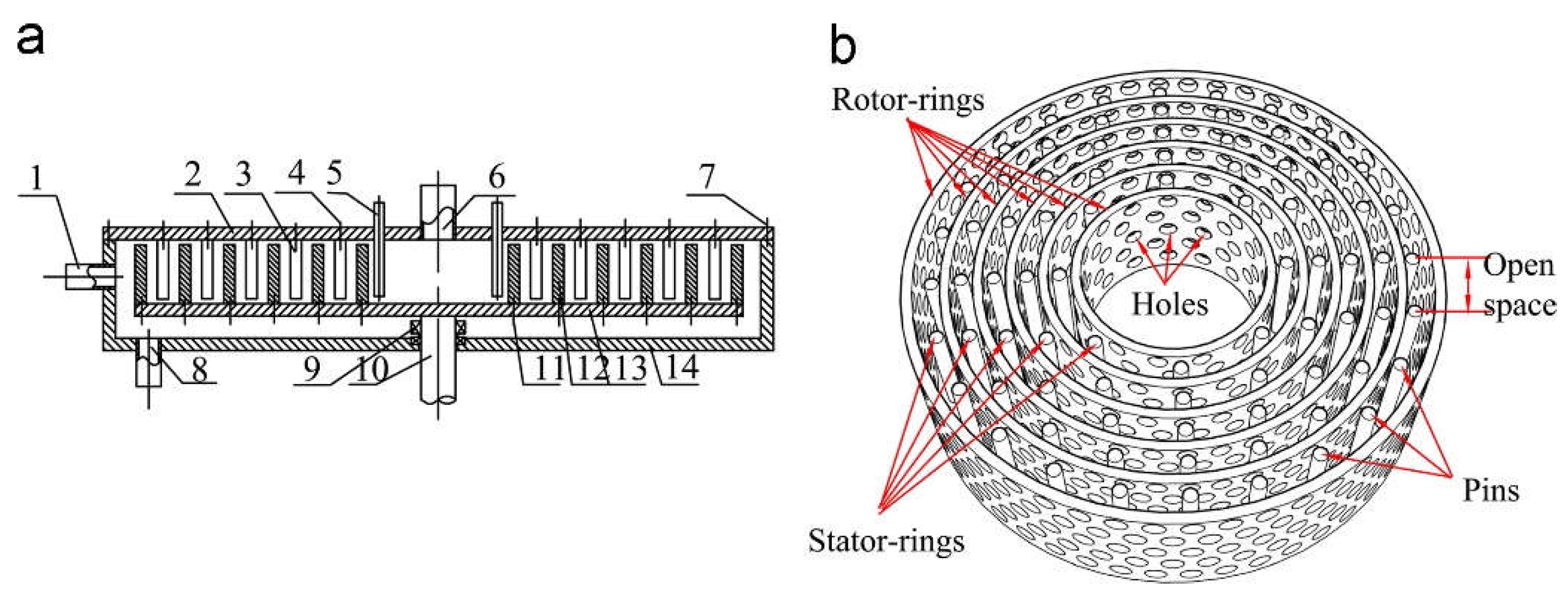
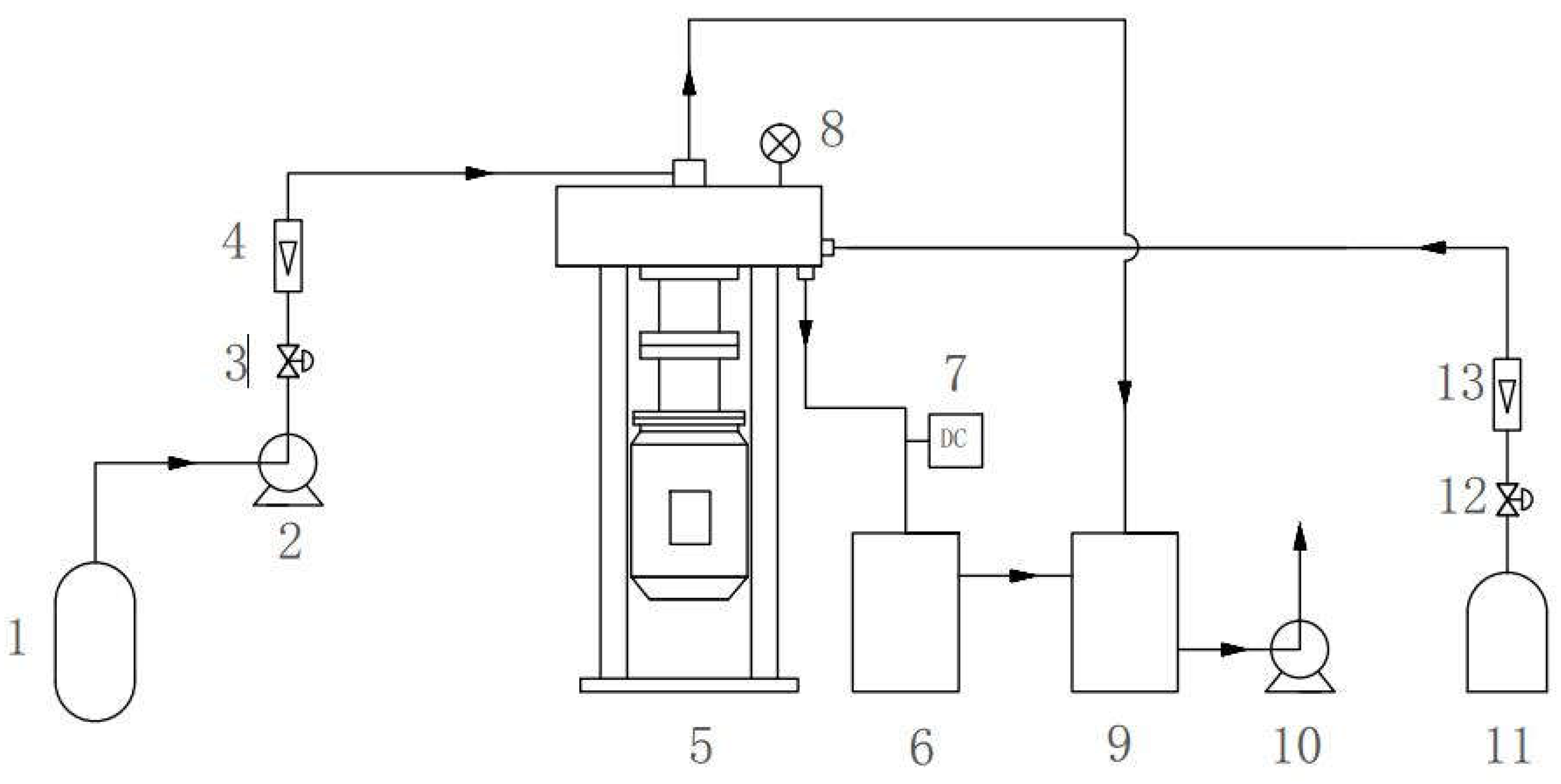
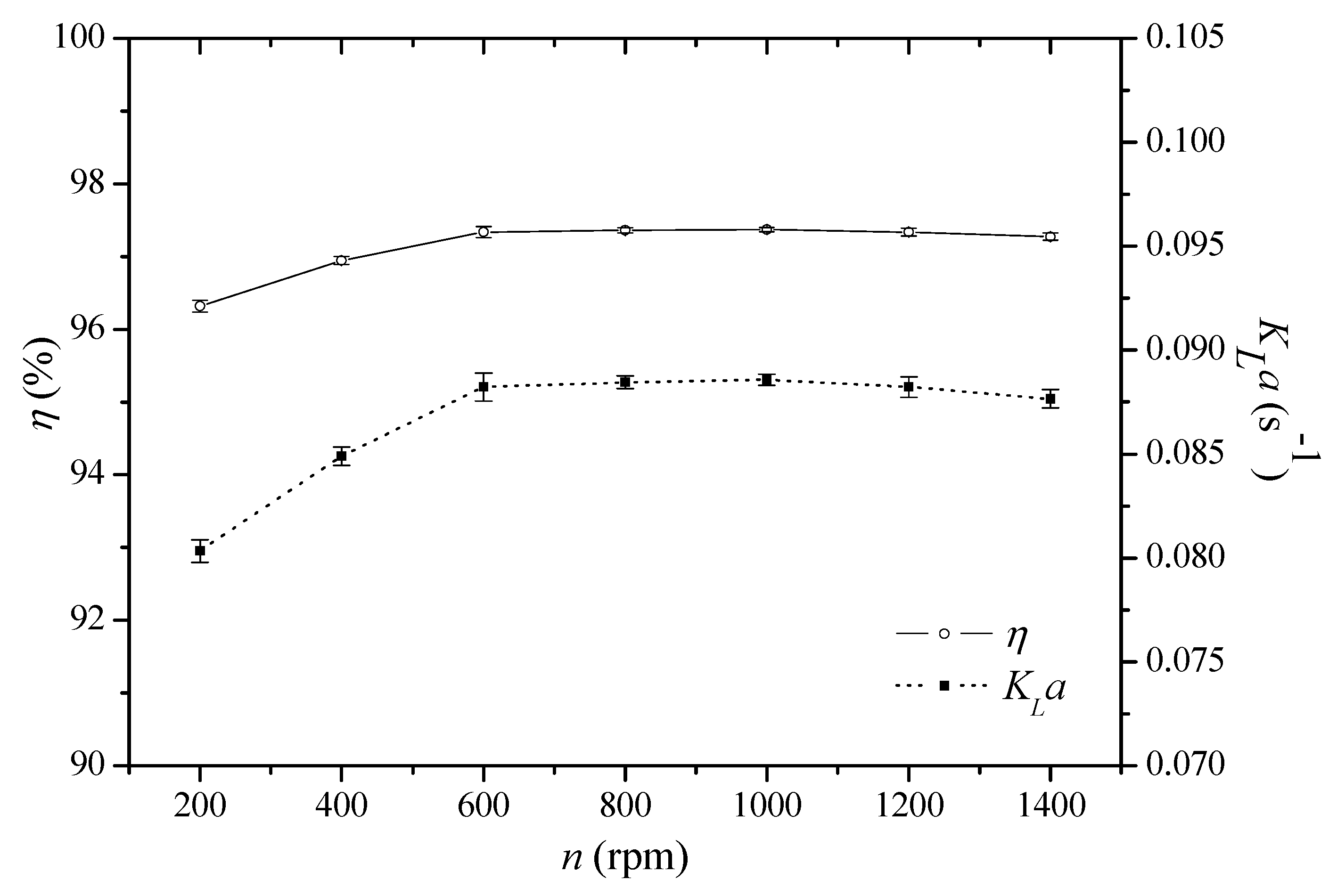
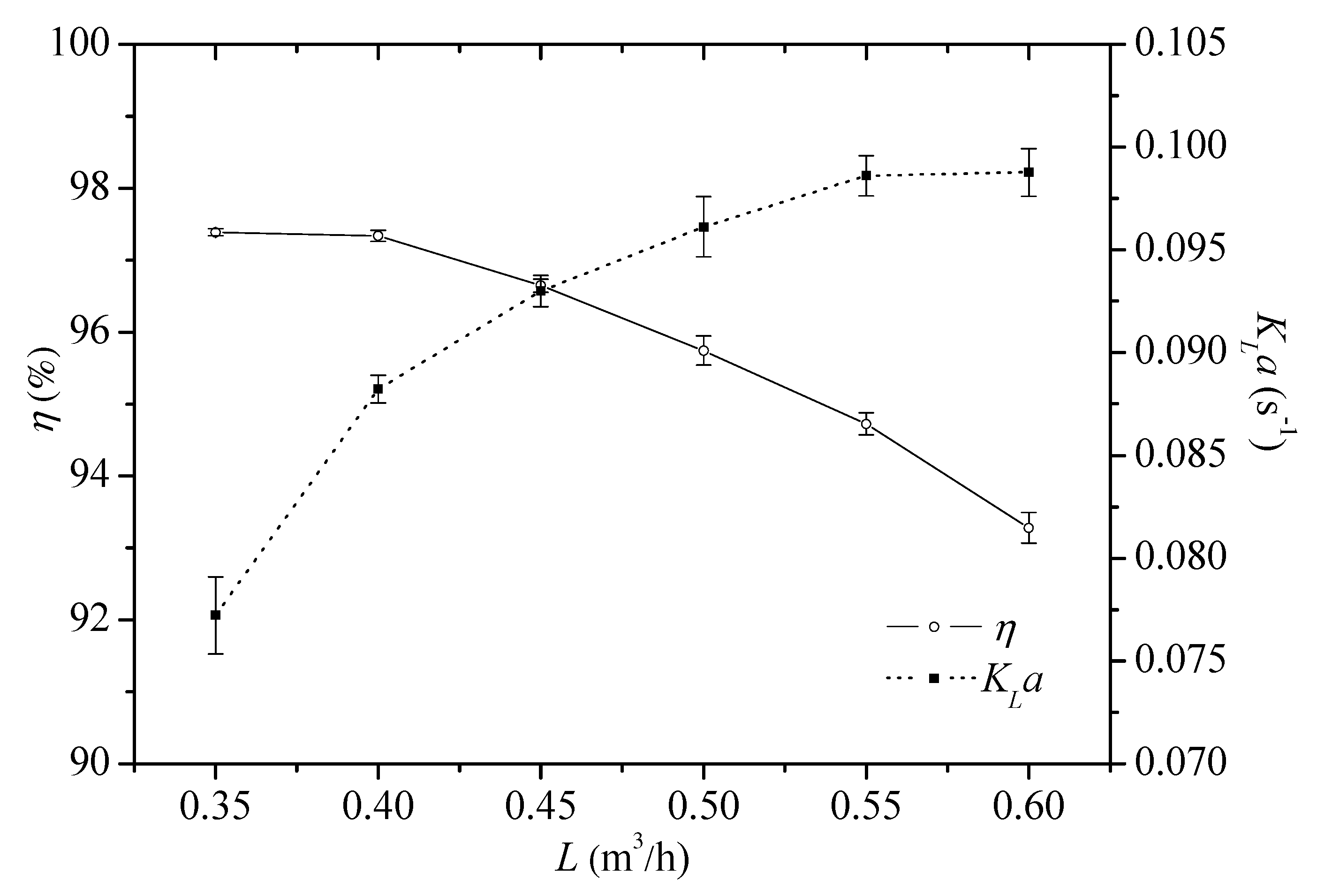
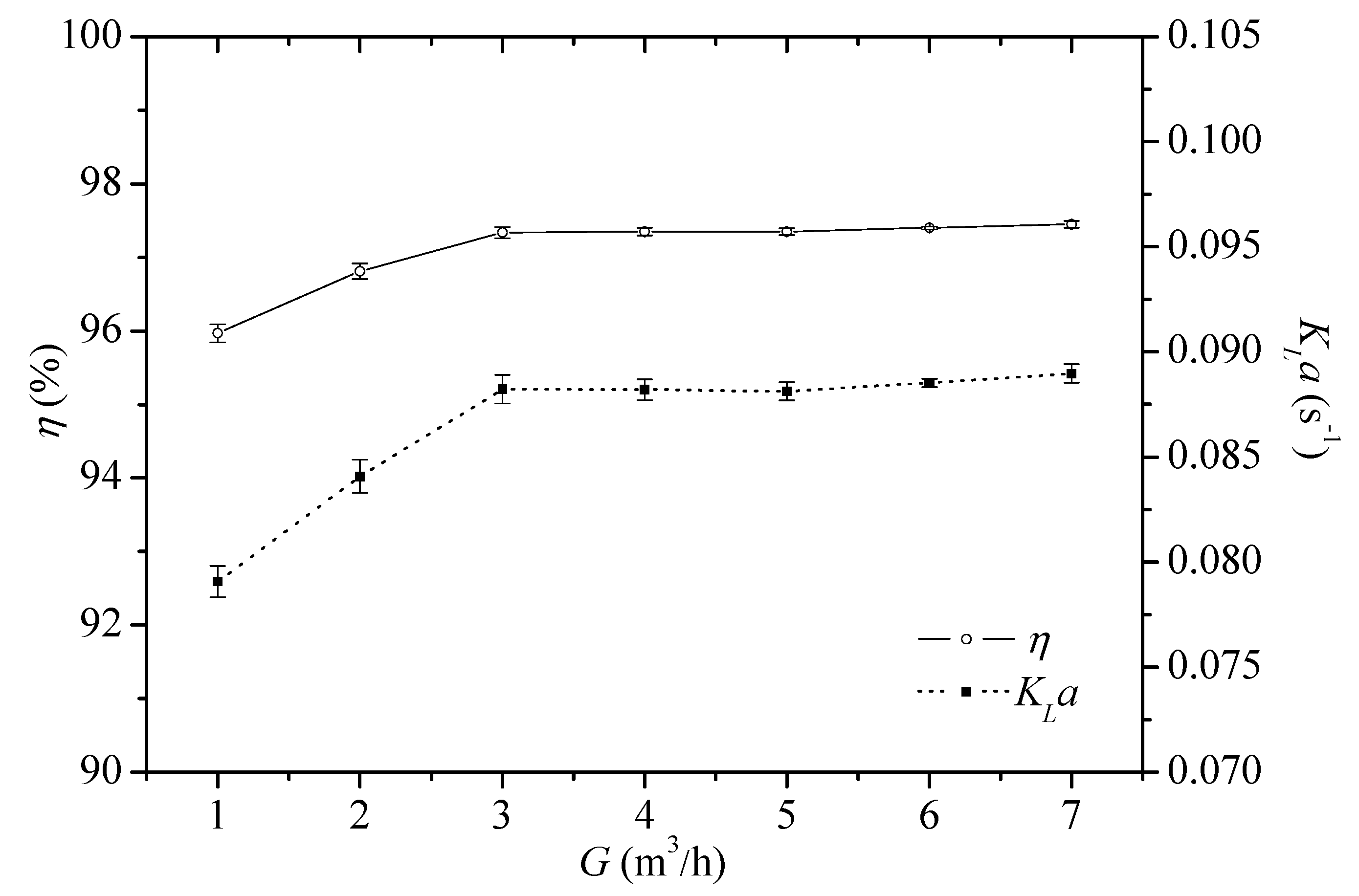
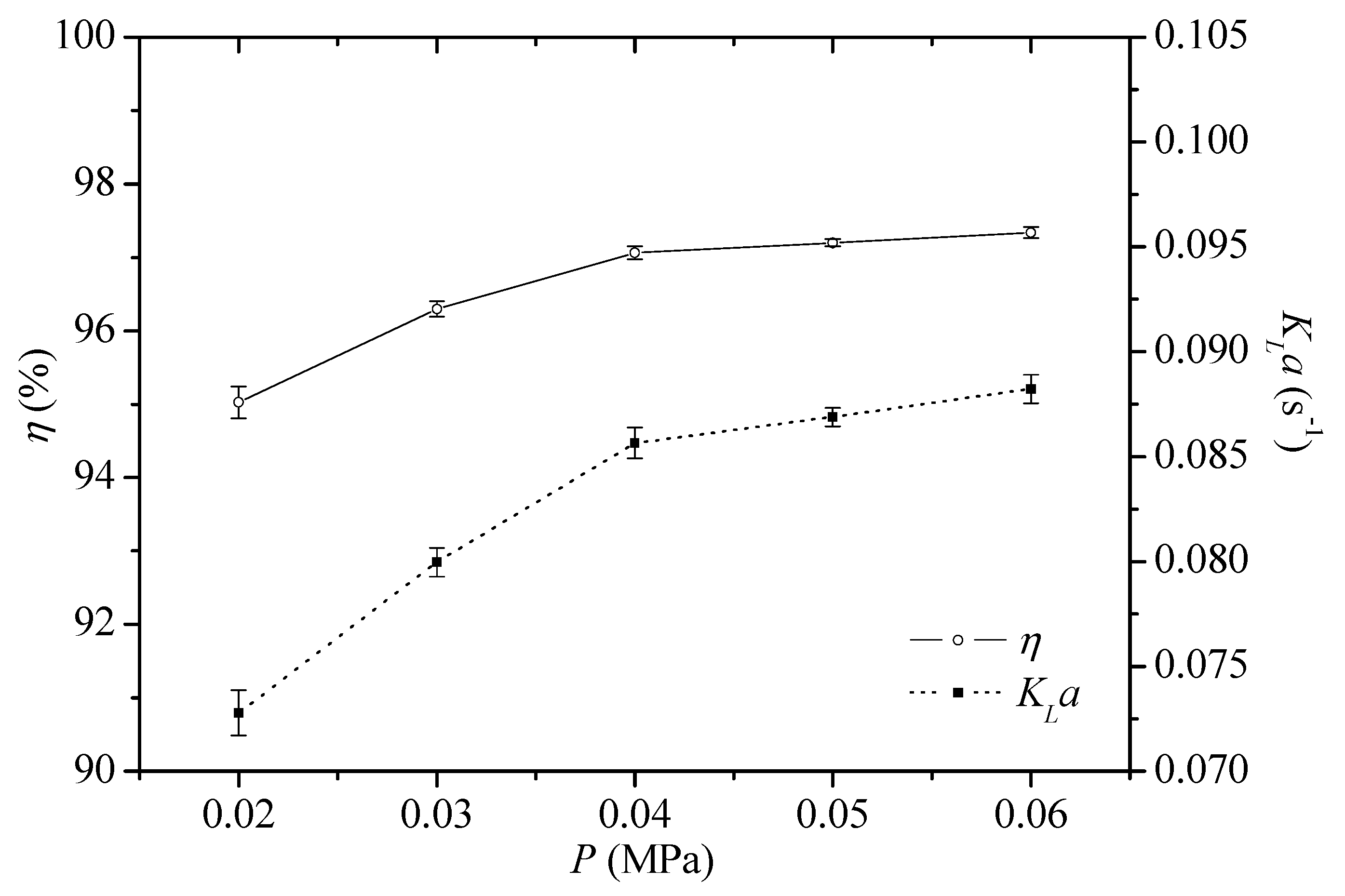
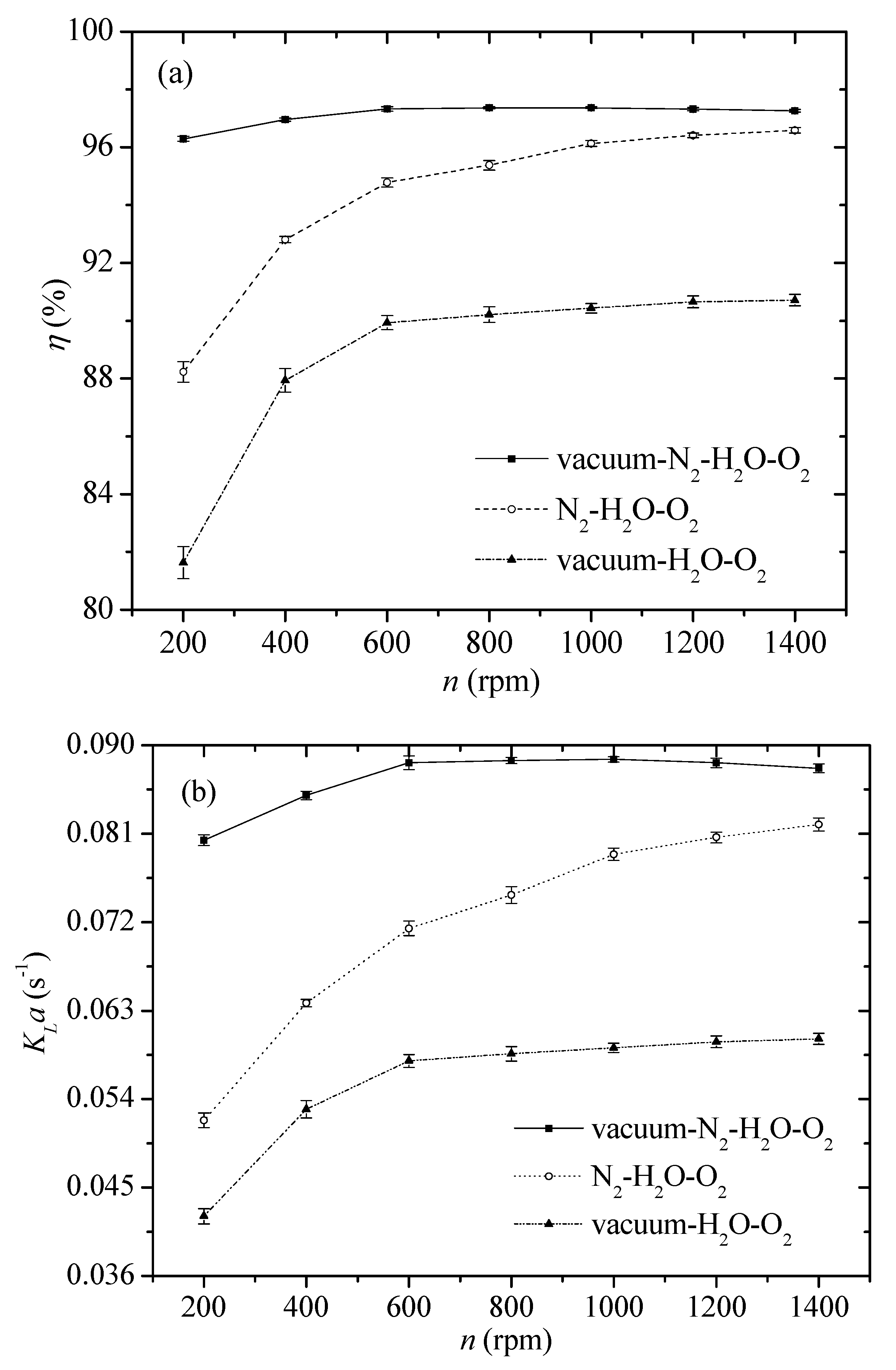

| Item | Unit | Value |
|---|---|---|
| Layer number of rotor rings | - | 6 |
| Layer number of stator rings | - | 5 |
| Number of perforations in rotor rings | - | 180, 240, 294, 348, 408, 462 |
| Number of pins in stator rings | - | 12, 16, 20, 24, 24 |
| Diameter of perforations in rotor rings | mm | 4 |
| Diameter of pins in stator rings | mm | 5 |
| Inner diameter of rotor rings | mm | 70, 94, 118, 142, 166, 190 |
| Inner diameter of stator rings | mm | 80, 104, 128, 152, 176 |
| Inner diameter of the RSR | mm | 300 |
| Axial depth of rotor rings | mm | 61 |
| Axial depth of stator rings | mm | 60 |
| Axial depth of the RSR | mm | 65 |
| Internal volume of the RSR | cm3 | 4592 |
| Factor | Symbol | Value | Unit | Dimension |
|---|---|---|---|---|
| Liquid inlet velocity | uL | 3.1~5.3 | m/s | [LT−1] |
| Angular velocity of rotor | ω | 21~147 | s−1 | [T−1] |
| Geometric radius of rotor | R | 0.115 | m | [L] |
| Liquid density | ρL | 997 | kg/m3 | [ML−3] |
| Liquid viscosity | μL | 8.94 × 10−4 | kg/(m·s) | [ML−1T−1] |
| Liquid surface tension | σ | 71.97 | kg/s2 | [MT−2] |
| Gravitational acceleration | g | 9.81 | m/s2 | [LT−2] |
| Temperature | T | 25~29 | °C | [Θ] |
| Inlet air humidity | φ | - | % | - |
| Gas inlet velocity | uG | 8.85~61.95 | m/s | [LT−1] |
| Gas density | ρG | 0.5~1.25 | kg/m3 | [ML−3] |
| Gas viscosity | μG | 1.78 × 10−5 | kg/(m·s) | [ML−1T−1] |
| Oxygen diffusivity in water | DAB | 2.41 × 10−9 | m2/s | [L−2T] |
| Vacuum degree | P | 0~0.06 | MPa | [L−1MT2] |
| Reference | This Study | Lin et al. | Guan et al. |
|---|---|---|---|
| System | Vacuum–N2–H2O–O2 | N2–H2O–O2 | Vacuum–H2O–O2 |
| High gravity device | RSR | RSR | Rotating packed bed |
| Liquid flow rate, m3/h | 0.35~0.6 | 0.75~2.0 | 0.02~0.10 |
| Gas flow rate, m3/h | 1~7 | 1.5~4.0 | - |
| Rotational speed, rpm | 200~1400 | 300~1450 | 800~1400 |
| Vacuum degree, MPa | 0.02~0.06 | 0 | 0.08~0.1 |
| Range of mass transfer coefficient, s−1 | 0.073~0.098 | 0.077~0.34 | 0.031~0.202 |
| Reference | - | [26] | [27] |
Publisher’s Note: MDPI stays neutral with regard to jurisdictional claims in published maps and institutional affiliations. |
© 2021 by the authors. Licensee MDPI, Basel, Switzerland. This article is an open access article distributed under the terms and conditions of the Creative Commons Attribution (CC BY) license (https://creativecommons.org/licenses/by/4.0/).
Share and Cite
Zhao, Z.; Liu, Z.; Xiang, Y.; Arowo, M.; Shao, L. Removal of Dissolved Oxygen from Water by Nitrogen Stripping Coupled with Vacuum Degassing in a Rotor–Stator Reactor. Processes 2021, 9, 1354. https://doi.org/10.3390/pr9081354
Zhao Z, Liu Z, Xiang Y, Arowo M, Shao L. Removal of Dissolved Oxygen from Water by Nitrogen Stripping Coupled with Vacuum Degassing in a Rotor–Stator Reactor. Processes. 2021; 9(8):1354. https://doi.org/10.3390/pr9081354
Chicago/Turabian StyleZhao, Zemeng, Zhibang Liu, Yang Xiang, Moses Arowo, and Lei Shao. 2021. "Removal of Dissolved Oxygen from Water by Nitrogen Stripping Coupled with Vacuum Degassing in a Rotor–Stator Reactor" Processes 9, no. 8: 1354. https://doi.org/10.3390/pr9081354
APA StyleZhao, Z., Liu, Z., Xiang, Y., Arowo, M., & Shao, L. (2021). Removal of Dissolved Oxygen from Water by Nitrogen Stripping Coupled with Vacuum Degassing in a Rotor–Stator Reactor. Processes, 9(8), 1354. https://doi.org/10.3390/pr9081354







